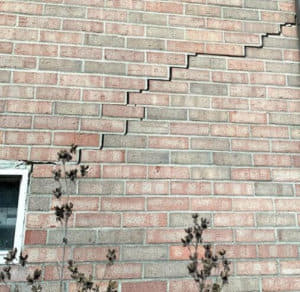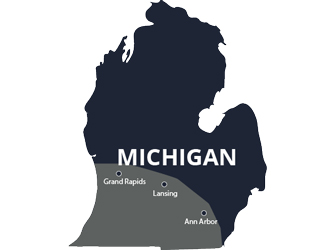Most people do not like surprises. Sure, you like the nice ones: a coworker brings in bagels for the office, your child takes out the trash without being asked, that sort of thing. But you hate the other surprises: a window that won’t open, a basement wall starting to bow, water seeping into your basement through a crack… You have good reasons to hate these surprises; they are problems that need fixing, and that costs money we don’t want to spend.
We mentioned those issues, because they are all signs of foundation problems. The best foundation repair for your home is the one that will thoroughly resolve the issue. This seems like an obvious response, but it’s easier said than done. You will first need an accurate and reliable diagnosis.
At Acculevel, we’ve been repairing foundations since Andy Beery started the company in 1996. We are family-owned and operated, with a service area that includes Indiana and portions of the surrounding states. We’ve repaired tens of thousands of homes, reestablishing stability, improving resale value, and restoring peace of mind to homeowners. Everyone should have a safe and healthy place to live, and deserves clear and honest information about home repairs.
In this article, we’re going to briefly explain how water (or a lack of it) can damage your foundation, detail the symptoms of damage you need to watch for, and explore the best repair methods for each type of problem. We will also provide additional resources to more fully address any questions you may have.
What Causes Foundation Problems?
In most cases, water is the guilty party. When there is too much water in the ground, the earth is oversaturated. This means the soil has absorbed all the water it can, and the excess is ‘looking’ for an outlet. This excess water presses against your foundation, creating external pressure on the concrete. This pressure causes cracked foundation walls, water seeping in the basement or crawl space, or bowing/leaning foundation walls. This type of force against your foundation is called hydrostatic pressure, and you can learn why it’s so problematic here.
If there is too little water in the ground, the reverse happens. As the soil dries out, it shrinks and pulls away from the foundation. As the earth below the foundation shifts, your foundation also shifts. If this shifting or settling isn’t done evenly, it causes the foundation to ‘sink’ at an inconsistent level. Once one corner or side of your foundation is lower than the other(s), this strains the structure of your entire home, creating cracks and uneven framing within the house. This article gives a more complete breakdown of drought and the problems it creates.
 This photo was taken by an Acculevel project manager during a free estimate appointment. The stair-step crack in the brick facade indicates the foundation is settling unevenly.
This photo was taken by an Acculevel project manager during a free estimate appointment. The stair-step crack in the brick facade indicates the foundation is settling unevenly.
What Are Signs of Foundation Problems?
Like many problems we face, there are degrees of difficulty involved. Some of these symptoms are minor issues; if you resolve them as soon as they’re discovered, the repairs needed won’t “break the bank.” Others pose a more significant risk, and can be more costly. We’ll present these in order of increasing significance and cost.
- Hairline cracks in the foundation. Is the crack only visible on the inside of the basement or crawl space? Is it letting in water? These are less severe, and we recommend an epoxy repair method.
- Long horizontal cracks or stair-step cracks on the inside of the foundation, possibly with a bowing or leaning wall. This is a clear sign of hydrostatic pressure forcing your basement wall to move, and it should be fixed promptly. The more the wall moves, the more expensive the repair becomes. There are several repair methods available for this issue, and we explain how each works and what it costs, here.
- Cracks in the drywall around windows/doors, sticking windows/doors, and external stair-step cracks. These are signs of a settling or sinking foundation. You may not have all three of these; in some cases, you may only have two of these symptoms. Helical piers are the best method for stabilizing and reinforcing a settling foundation; we explain how they work and what they cost in this article.
- A note about #3: if you have only cracks in your drywall, but no sticking entries or cracks in the foundation, check the wooden structure under your floor. Drywall cracks can be a sign of a sloping or sagging floor, which we explore in greater detail here.
 This photo was taken by an Acculevel project manager during a free estimate appointment. The cracks, both stair-step and horizontal, are signs of a basement wall beginning to bow inward.
This photo was taken by an Acculevel project manager during a free estimate appointment. The cracks, both stair-step and horizontal, are signs of a basement wall beginning to bow inward.
Do You Have Additional Questions about Foundation Repairs?
If the answer is yes, I encourage you to check out our free comprehensive guide to foundation repairs. It can be read in its entirety, you can select the chapter relevant to you, or bookmark it as a reference when you meet with contractors.
If You’re Ready to Start Meeting with Contractors?
We encourage every homeowner to include the Better Business Bureau; they can help you verify that the company you choose is reputable, and insured.
You are also welcome to use our guide to questions you should ask a contractor. The initial article provides Acculevel’s answers to these questions, and includes a link to a free (blank) form you can download.
If you live in Indiana or the surrounding states, contact Acculevel. We provide free written estimates, performed by one of our experienced project managers. They will evaluate your foundation and recommend the best course of action for you. Our goal is to help you keep your home strong and healthy for years to come.




















